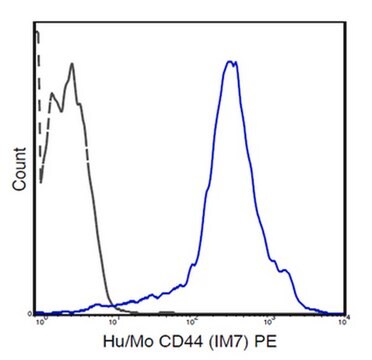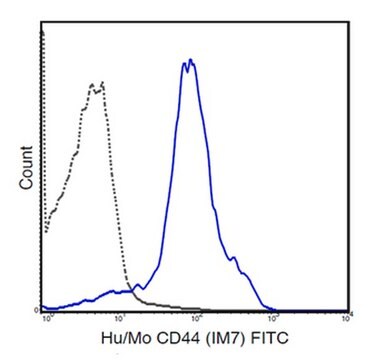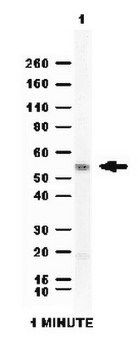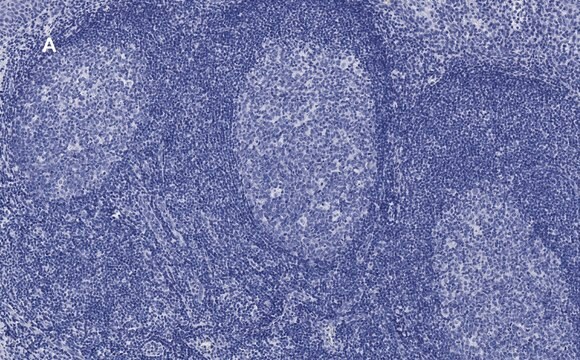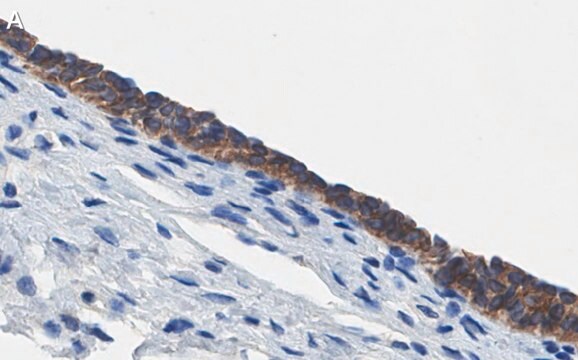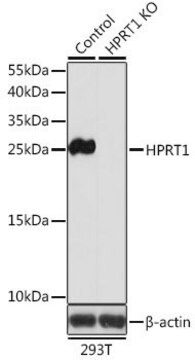SAB4700182
Monoclonal Anti-CD44-FITC antibody produced in mouse
clone MEM-85, purified immunoglobulin, buffered aqueous solution
Synonim(y):
Anti-Pgp-1
Zaloguj sięWyświetlanie cen organizacyjnych i kontraktowych
About This Item
Kod UNSPSC:
12352203
NACRES:
NA.44
Polecane produkty
pochodzenie biologiczne
mouse
Poziom jakości
białko sprzężone
FITC conjugate
forma przeciwciała
purified immunoglobulin
rodzaj przeciwciała
primary antibodies
klon
MEM-85, monoclonal
Formularz
buffered aqueous solution
reaktywność gatunkowa
human
metody
flow cytometry: suitable
izotyp
IgG2b
numer dostępu NCBI
numer dostępu UniProt
Warunki transportu
wet ice
temp. przechowywania
2-8°C
docelowa modyfikacja potranslacyjna
unmodified
informacje o genach
human ... CD44(960)
Opis ogólny
Gen CD44 (glikoproteina powierzchniowa komórek) z 20 eksonami jest mapowany na ludzkim chromosomie 11p13. Gen koduje transbłonową glikoproteinę.
Przeciwciało MEM-85 reaguje zarówno z wyrażoną na powierzchni komórki, jak i rozpuszczalną formą antygenu CD44 (glikoproteina fagocytów 1), przezbłonowej glikoproteiny 80-95 kDa (rodzina hialadheryn) obecnej na większości komórek i tkanek (leukocytach, komórkach śródbłonka, komórkach mezenchymalnych itp.); jest ujemne na płytkach krwi i hepatocytach.
Immunogen
Leukocyty pacjenta cierpiącego na białaczkę typu LGL.
Zastosowanie
Monoklonalne przeciwciało anty-CD44-FITC wytwarzane u myszy zostało użyte jako odczynnik do odróżnienia komórek HeLa (nowotworowych) od komórek chondrocytów (prawidłowych).
Odczynnik jest przeznaczony do analizy komórek krwi ludzkiej metodą cytometrii przepływowej przy użyciu 20 μL odczynnika / 100 μL krwi pełnej lub 1e6 komórek w zawiesinie. Zawartość fiolki (2 ml) wystarcza na 100 testów.
Działania biochem./fizjol.
CD44 (glikoproteina powierzchniowa komórki) bierze udział w interakcjach komórka-komórka i komórka-macierz zewnątrzkomórkowa. Odgrywa ważną rolę w naprowadzaniu limfocytów i ich aktywacji. Działa również jako gen supresorowy przerzutów w raku prostaty. Nadekspresja CD44 prowadzi do raka płaskonabłonkowego przełyku (ESCC). CD44 hamuje multinukleację makrofagów poprzez interakcję ze swoimi ligandami, kwasem hialuronowym, siarczanami chondroityny i osteopontyną. Forma CD44 o masie 100 kDa ułatwia wiązanie wirusa polio z komórkami HeLa. Ponadto, jest ona również zaangażowana w infekcję fagocytów jednojądrzastych ludzkim wirusem niedoboru odporności (HIV).
Cechy i korzyści
Oceń nasze przeciwciała z pełnym spokojem. Jeśli przeciwciało nie sprawdzi się w danym zastosowaniu, zwrócimy pełną kwotę lub dostarczymy przeciwciało zastępcze. Dowiedz się więcej..
Postać fizyczna
Solution in phosphate buffered saline containing 15 mM sodium azide and 0.2% high-grade protease free BSA as a stabilizing agent.
Oświadczenie o zrzeczeniu się odpowiedzialności
O ile nie określono inaczej w naszym katalogu lub innej dokumentacji firmy dołączonej do produktu(-ów), nasze produkty są przeznaczone wyłącznie do użytku badawczego i nie mogą być wykorzystywane do żadnych innych celów, w tym między innymi do nieautoryzowanych zastosowań komercyjnych, zastosowań diagnostycznych in vitro, zastosowań terapeutycznych ex vivo lub in vivo lub jakiegokolwiek rodzaju konsumpcji lub zastosowania u ludzi lub zwierząt.
Ta strona może zawierać tekst przetłumaczony maszynowo.
Nie możesz znaleźć właściwego produktu?
Wypróbuj nasz Narzędzie selektora produktów.
Kod klasy składowania
10 - Combustible liquids
Klasa zagrożenia wodnego (WGK)
WGK 2
Temperatura zapłonu (°F)
Not applicable
Temperatura zapłonu (°C)
Not applicable
Wybierz jedną z najnowszych wersji:
Masz już ten produkt?
Dokumenty związane z niedawno zakupionymi produktami zostały zamieszczone w Bibliotece dokumentów.
Fabrication and modification of dual-faced nano-mushrooms for tri-functional
cell theranostics: SERS/fluorescence signaling, protein targeting, and drug
delivery?
Hsieh H Y
Journal of Materials Chemistry, 22, 20918?20928-20918?20928 (2012)
Musashi-1 promotes a cancer stem cell lineage and chemoresistance in colorectal cancer cells.
Chiou GY
Scientific Reports, 7 (2017)
CD44 occupancy prevents macrophage multinucleation.
Sterling H
The Journal of Cell Biology, 143, 837-847 (1998)
Autophagy supports generation of cells with high CD44 expression via modulation of oxidative stress and Parkin-mediated mitochondrial clearance
Whelan KA
Oncogene, 36, 4843-4858 (2017)
Guang-Yuh Chiou et al.
Scientific reports, 7(1), 2172-2172 (2017-05-21)
Colorectal cancers (CRCs) are a critical health issue worldwide. Cancer stem cell (CSC) lineages are associated with tumour transformation, progression, and malignant transformation. However, how lineages are transformed and how chemoresistance is acquired by CRCs remain largely unknown. In this
Global Trade Item Number
| SKU | GTIN |
|---|---|
| SAB4700182-100TST | 4061832706344 |
Nasz zespół naukowców ma doświadczenie we wszystkich obszarach badań, w tym w naukach przyrodniczych, materiałoznawstwie, syntezie chemicznej, chromatografii, analityce i wielu innych dziedzinach.
Skontaktuj się z zespołem ds. pomocy technicznej